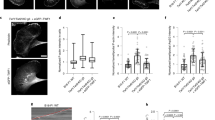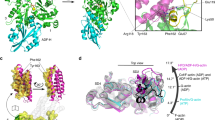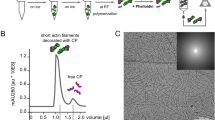Abstract
Factors that are involved in actin polymerization, such as the Arp2/3 complex, have been found to be packaged into discrete, motile, actin-rich foci. Here we investigate the mechanism of actin-patch motility in S. pombe using a fusion of green fluorescent protein (GFP) to a coronin homologue, Crn1p. Actin patches are associated with cables and move with rates of 0.32 μm s−1 primarily in an undirected manner at cell tips and also in a directed manner along actin cables, often away from cell tips. Patches move more slowly or stop when actin polymerization is attenuated by Latrunculin A or in arp3 and cdc3 (profilin) mutants. In a cdc8 (tropomyosin) mutant, actin cables are absent, and patches move with similar speed but in a non-directed manner. Patches are sites of Arp3-dependent F-actin polymerization in vitro. Rapid F-actin turnover rates in vivo indicate that patches and cables are maintained continuously by actin polymerization. Our studies give rise to a model in which actin patches are centres for actin polymerization that drive their own movement on actin cables using Arp2/3-based actin polymerization.
This is a preview of subscription content, access via your institution
Access options
Subscribe to this journal
Receive 12 print issues and online access
$209.00 per year
only $17.42 per issue
Buy this article
- Purchase on Springer Link
- Instant access to full article PDF
Prices may be subject to local taxes which are calculated during checkout







Similar content being viewed by others
References
Mullins, R. D. & Pollard, T. D. Structure and function of the Arp2/3 complex. Curr. Opin. Struct. Biol. 9, 244–249 (1999).
Welch, M. D. The world according to Arp: regulation of actin nucleation by the Arp2/3 complex . Trends Cell Biol. 9, 423– 427 (1999).
Pruyne, D. & Bretscher, A. Polarization of cell growth in yeast. J. Cell Sci. 113, 365– 375 (2000).
Schafer, D. A. et al. Visualization and molecular analysis of actin assembly in living cells. J. Cell Biol. 143, 1919– 1930 (1998).
Botstein, D. et al. in Cell Cycle and Cell Biology (eds Pringle, J. R., Broach, J. R. & Jones, E. W.) 1–90 (Cold Spring Harbor Laboratory Press, Plainview, New York, 1997).
Li, R., Zheng, Y. & Drubin, D. G. Regulation of cortical actin cytoskeleton assembly during polarized cell growth in budding yeast. J. Cell Biol. 128, 599–615 (1995).
Winter, D., Podtelejnikov, A. V., Mann, M. & Li, R. The complex containing actin-related proteins Arp2 and Arp3 is required for the motility and integrity of yeast actin patches. Curr. Biol. 7, 519–529 (1997).
Doyle, T. & Botstein, D. Movement of yeast cortical actin cytoskeleton visualized in vivo. Proc. Natl Acad. Sci. USA 93, 3886–3891 ( 1996).
Waddle, J. A., Karpova, T. S., Waterston, R. H. & Cooper, J. A. Movement of cortical actin patches in yeast. J. Cell Biol. 132, 861–870 (1996).
Tilney, L. G. & Portnoy, D. A. Actin filaments and the growth, movement, and spread of the intracellular bacterial parasite, Listeria monocytogenes. J. Cell Biol. 109, 1597 –1608 (1989).
Merrifield, C. J. et al. Endocytic vesicles move at the tips of actin tails in cultured mast cells. Nature Cell Biol. 1, 72– 74 (1999).
May, R. C., Emmanuelle, C., Hall, A. & Machesky, L. M. Involvement of the Arp2/3 complex in phagocytosis mediated by FcγR of CR3. Nature Cell Biol. 2, 246–248 (2000).
Taunton, J. et al. Actin-dependent propulsion of endosomes and lysosomes by recruitment of N-WASP. J. Cell Biol. 148, 519– 530 (2000).
Rozelle, A. L. et al. Phosphatidylinositol 4,5-bisphosphate induces actin-based movement of raft-enriched vesicles through WASP-Arp2/3. Curr. Biol. 10, 311–320 ( 2000).
Belmont, L. D. & Drubin, D. G. The yeast V159N actin mutant reveals roles for actin dynamics in vivo. J. Cell Biol. 142, 1289–1299 (1998).
Marks, J. & Hyams, J. S. Localization of F-actin through the cell division cycle of Schizosaccharomyces pombe. Eur. J. Cell Biol. 39, 27–32 (1985).
Marks, J., Hagan, I. M. & Hyams, J. S. Growth polarity and cytokinesis in fission yeast: the role of the cytoskeleton. J. Cell Sci. (Suppl.) 5, 229–241 (1986).
Nurse, P., Thuriaux, P. & Nasmyth, K. Genetic control of the cell division cycle in the fission yeast Schizosaccharomyces pombe. Mol. Gen. Genet. 146, 167–178 (1976).
Chang, F., Woollard, A. & Nurse, P. Isolation and characterization of fission yeast mutants defective in the assembly and placement of the contractile actin ring. J. Cell Sci. 109, 131–142 (1996).
Balasubramanian, M. K. et al. Isolation and characterization of new fission yeast cytokinesis mutants. Genetics 149, 1265– 1275 (1998).
McCollum, D., Feoktistova, A., Morphew, M., Balasubramanian, M. & Gould, K. L. The Schizosaccharomyces pombe actin-related protein, Arp3, is a component of the cortical actin cytoskeleton and interacts with profilin. EMBO J. 15 , 6438–6446 (1996).
Morrell, J. L., Morphew, M. & Gould, K. L. A mutant of arp2p causes partial disassembly of the Arp2/3 complex and loss of cortical actin function in fission yeast. Mol. Biol. Cell 10, 4201–4215 (1999).
Balasubramanian, M. K., Helfman, D. M. & Hemmingsen, S. M. A new tropomyosin essential for cytokinesis in the fission yeast S. pombe. Nature 360, 84–87 (1992).
Arai, R., Nakano, K. & Mabuchi, I. Subcellular localization and possible function of actin, tropomyosin and actin-related protein 3 (Arp3) in the fission yeast Schizosaccharomyces pombe. Eur. J. Cell Biol. 76, 288– 295 (1998).
Goode, B. L. et al. Coronin promotes the rapid assembly and cross-linking of actin filaments and may link the actin and microtubule cytoskeletons in yeast. J. Cell Biol. 144, 83–98 (1999).
Heil-Chapdelaine, R. A., Tran, N. K. & Cooper, J. A. The role of Saccharomyces cerevisiae coronin in the actin and microtubule cytoskeletons. Curr. Biol. 8, 1281–1284 (1998).
de Hostos, E. L. The coronin family of actin-associated proteins. Trends Cell Biol. 9, 345–350 ( 1999).
Ayscough, K. R. et al. High rates of actin filament turnover in budding yeast and roles for actin in establishment and maintenance of cell polarity revealed using the actin inhibitor latrunculin-A. J. Cell Biol. 137, 399–416 (1997).
Morton, W. M., Ayscough, K. R. & McLaughlin, P. J. Latrunculin alters the actin-monomer subunit interface to prevent polymerization. Nature Cell Biol. 2, 376–378 (2000).
Eng, K., Naqvi, N. I., Wong, K. C. & Balasubramanian, M. K. Rng2p, a protein required for cytokinesis in fission yeast, is a component of the actomyosin ring and the spindle pole body. Curr. Biol. 8, 611–621 (1998).
Welch, M. D., Iwamatsu, A. & Mitchison, T. J. Actin polymerization is induced by Arp2/3 protein complex at the surface of Listeria monocytogenes. Nature 385, 265–269 ( 1997).
Loisel, T. P., Boujemaa, R., Pantaloni, D. & Carlier, M. F. Reconstitution of actin-based motility of Listeria and Shigella using pure proteins. Nature 401, 613 –616 (1999).
Lillie, S. H. & Brown, S. S. Immunofluorescence localization of the unconventional myosin, Myo2p, and the putative kinesin-related protein, Smy1p, to the same regions of polarized growth in Saccharomyces cerevisiae . J. Cell Biol. 125, 825– 842 (1994).
Pruyne, D. W., Schott, D. H. & Bretscher, A. Tropomyosin-containing actin cables direct the Myo2p-dependent polarized delivery of secretory vesicles in budding yeast. J. Cell Biol. 143, 1931–1945 ( 1998).
Mata, J. & Nurse, P. 1tea1 and the microtubular cytoskeleton are important for generating global spatial order within the fission yeast cell. Cell 89, 939–949 (1997).
Sawin, K. E. & Nurse, P. Regulation of cell polarity by microtubules in fission yeast. J. Cell Biol. 142, 457 –471 (1998).
De Brabander, M. J., Van de Veire, R. M., Aerts, F. E., Borgers, M. & Janssen, P. A. The effects of methyl (5-(2-thienylcarbonyl)-1H-benzimidazol-2-yl) carbamate, (R 17934; NSC 238159), a new synthetic antitumoral drug interfering with microtubules, on mammalian cells cultured in vitro. Cancer Res. 36, 905–916 (1976).
Quinlan, R. A., Pogson, C. I. & Gull, K. The influence of the microtubule inhibitor, methyl benzimidazol-2-yl-carbamate (MBC) on nuclear division and the cell cycle in Saccharomyces cerevisiae . J. Cell Sci. 46, 341– 352 (1980).
Backx, P. H., Gao, W. D., Azan-Backx, M. D. & Marban, E. Mechanism of force inhibition by 2,3-butanedione monoxime in rat cardiac muscle: roles of [Ca2+]i and cross-bridge kinetics. J. Physiol. (Lond) 476, 487–500 (1994).
Cramer, L. P. & Mitchison, T. J. Myosin is involved in postmitotic cell spreading. J. Cell Biol. 131, 179– 189 (1995).
May, K. M., Wheatley, S. P., Amin, V. & Hyams, J. S. The myosin ATPase inhibitor 2,3-butanedione-2-monoxime (BDM) inhibits tip growth and cytokinesis in the fission yeast, Schizosaccharomyces pombe . Cell Motil. Cytoskeleton 41, 117– 125 (1998).
Lechler, T., Shevchenko, A., & Li, R. Direct involvement of yeast type I myosins in Cdc42-dependent actin polymerization. J. Cell Biol. 148, 363–373 (2000).
Winter, D., Lechler, T. & Li, R. Activation of the yeast Arp2/3 complex by Bee1p, a WASP-family protein. Curr. Biol. 9, 501–504 ( 1999).
Karpova, T. S., McNally, J. G., Moltz, S. L. & Cooper, J. A. Assembly and function of the actin cytoskeleton of yeast: relationships between cables and patches. J. Cell Biol. 142, 1501 –1517 (1998).
Borisy, G. G. & Svitkina, T. M. Actin machinery: pushing the envelope. Curr. Opin. Cell Biol. 12, 104 –112 (2000).
Bahler, J. et al. Heterologous modules for efficient and versatile PCR-based gene targeting in Schizosaccharomyces pombe. Yeast 14, 943–951 (1998).
Chang, F. Movement of a cytokinesis factor cdc12p to the site of cell division. Curr. Biol. 9, 849–852 ( 1999).
Ding, D. Q., Chikashige, Y., Haraguchi, T. & Hiraoka, Y. Oscillatory nuclear movement in fission yeast meiotic prophase is driven by astral microtubules, as revealed by continuous observation of chromosomes and microtubules in living cells. J. Cell Sci. 111, 701–712 (1998).
Acknowledgements
We thank B. Goode for showing us the S. pombe coronin homologue sequence in the database, and L. Pon and members of her laboratory for discussions and insights. We also thank K. Gould for the arp3 strain, D. Drubin for LatA, J. Q. Wu and J. Bahler for kanMX plasmids, S. Randall (Improvision), and B. Semon (Morrell Instruments, New Jersey) for microscopy support, and R. Lustig for technical assistance. We are grateful to B. Feierbach for assistance with molecular biology and for support and suggestions throughout this study. We thank L. Pon, B. Feierbach and D. Drubin and his laboratory for comments on the manuscript. R.J.P. was supported by an NIH predoctoral training grant; FC was supported by the NIH, the American Cancer Society, a March of Dimes Basil O'Connor Scholar award and the Irma T. Hirschl Charitable Trust.
Author information
Authors and Affiliations
Corresponding author
Supplementary information
Movie 1
Three-dimensional images of the S. pombe actin cytoskeleton. Rotating image of a three-dimensional reconstruction of wild-type cells stained with phalloidin-conjugated AlexaFluor 488 to visualize the actin cytoskeleton. Cells are slightly flattened because of pressure from the coverslip. Individual frames are pre-sented sequentially at projections of 2° angles, rotating about the y-axis. (MOV 396 kb)
Movie 2
Three-dimensional images of the S. pombe actin cytoskeleton. Rotating image of a three-dimensional reconstruction of wild-type cells as in Movie 1, rotating about the x-axis. (MOV 403 kb)
Movie 3
Actin patches are highly dynamic. Time-lapse recording of actin-patch dynamics in S. pombe cells expressing Crn1p–GFP, which labels actin patches. Images are two-dimensional projections of 5 optical sections (1 μm). The time inter-val between frames is 5 s. Scale bar represents 5 μm. (MOV 176 kb)
Movie 4
Actin patches are located both in the cytoplasm and in association with the cell cortex. Series of optical sections of a wild-type cell expressing Crn1p–GFP. Eighteen optical sections are spaced 0.2 μm apart and go from the upper cell surface to the lower. Scale bar represents 5 μm. (MOV 188 kb)
Movie 5
Actin patches exhibit directed and non-directed movements. Time-lapse recording of actin patches exhibiting directed movement along linear tracks, and non-directed movement at cell tips. The time interval between frames is 0.5 s. The first frame is represented by Fig. 2a, 0 s. Scale bar represents 5 μm. (MOV 164 kb)
Movie 6
Time-lapse recording of an actin patch exhibiting directed movement along a Crn1p–GFP cable. The time interval between frames is 0.5 s. The first frame is rep-resented by Fig. 2a, 0 s. Scale bar represents 5 μm. (MOV 245 kb)
Movie 7
Movement of actin patches requires actin polymerization. Time-lapse recording showing inhibition of actin-patch movement after attenuation of actin polymerization. Cells were treated with 50 μm LatA for 2 min and movement of Crn1p–GFP patches in live cells was then recorded. Inhibition of actin polymerization with LatA abolishes actin-patch movement. The time interval between frames is 0.5 s. The first frame is represented by Fig. 3a, left panel. Scale bar represents 5μm. (MOV 769 kb)
Movie 8
Wild-type control treated with 1% dimethylsulphoxide (DMSO). Control time-lapse recording of actin patch-movement after treatment with 1% DMSO for 2 min. This treatment does not affect the pattern or rate of actin-patch movement. The time interval between frames is 0.5 s. The first frame is represent-ed by Fig. 3a, right panel. Scale bar represents 5 μm. (MOV 198 kb)
Movie 9
Arp3 is required for movement of actin patches. Time-lapse recording showing reduction of actin-patch movement in the cold-sensitive arp3 mutant. Cells were shifted to 19 °C for 100 min before imaging Crn1p–GFP fluorescence. The time interval between frames is 0.5 s. The first frame is represented by Fig. 4a, arp3. Scale bar represents 5 µm. (MOV 742 kb)
Movie 10
Profilin is required for movement of actin patches. Time-lapse recording showing reduction of actin-patch movement in the temperature-sensitive cdc3 (profilin) mutant. Cells were shifted to 36 °C for 4 h before imaging Crn1p–GFP fluorescence. The time interval between frames is 0.5 s. The first frame is represented by Fig. 4a, cdc3. Scale bar represents 5 μm. (MOV 209 kb)
Movie 11
Microtubules are not required for movement of actin patches. Time-lapse recording showing that actin-patch movement is unaffected in cells treated with 25 mg ml–1 MBC for 10 min to depolymerize microtubules. The time interval between frames is 0.5 s. The first frame is represented by Fig. 4a, +MBC. Scale bar represents 5 μm. (MOV 1441 kb)
Movie 12
Wild-type control treated with 1% DMSO. Control time-lapse record-ing of actin-patch movement after treatment with 1% DMSO for 10 min. This treat-ment does not effect the pattern or rate of actin-patch movement. The time interval between frames is 0.5 s. The first frame is represented by Fig. 4a, + 1% DMSO. Scale bar represents 5 μm. (MOV 1853 kb)
Movie 13
Wild-type 36 °C control. Control time-lapse recording of actin-patch movement after a shift to 36 °C for 4 h. Incubation at 36 °C does not effect the pattern or rate of actin-patch movement. The time interval between frames is 0.5 s. The first frame is represented by Fig. 4a, 36 °C. Scale bar represents 5 μm. (MOV 1897 kb)
Movie 14
Wild-type 19 °C control. Control time-lapse recording of actin-patch movement after a shift to 19 °C for 100 min. Incubation at 19 °C does not effect the pattern or rate of actin-patch movement. The time interval between frames is 0.5 s. The first frame is represented by Fig. 4a, 19 °C. Scale bar represents 5 μm. (MOV 1756 kb)
Movie 15
Directional movement of actin patches requires tropomyosin. Time-lapse recording showing loss of directed actin-patch movement in the temperature- sensitive cdc8 (tropomyosin) mutant, which lacks actin cables. Cells were shifted to 35.5 °C for 25 min before imaging Crn1p–GFP fluorescence. The time interval between frames is 0.5 s. The first frame is represented by Fig. 5a, cdc8. Scale bar represents 5 μm. (MOV 251 kb)
Movie 16
Wild-type 35.5 °C control after 25 min. Control time-lapse recording of actin-patch movement after a shift to 35.5 °C for 25 min. Incubation at 35.5 °C does not effect the pattern or rate of actin-patch movement. The time interval between frames is 0.5 s. The first frame is represented by Fig. 5a, wild type. Scale bar represents 5 μm. (MOV 472 kb)
Rights and permissions
About this article
Cite this article
Pelham, R., Chang, F. Role of actin polymerization and actin cables in actin-patch movement in Schizosaccharomyces pombe. Nat Cell Biol 3, 235–244 (2001). https://doi.org/10.1038/35060020
Received:
Revised:
Accepted:
Published:
Issue Date:
DOI: https://doi.org/10.1038/35060020
This article is cited by
-
Negative control of cytokinesis by stress-activated MAPK signaling
Current Genetics (2021)
-
Still and rotating myosin clusters determine cytokinetic ring constriction
Nature Communications (2016)
-
Actin organization and dynamics in filamentous fungi
Nature Reviews Microbiology (2011)
-
Changes in gravity rapidly alter the magnitude and direction of a cellular calcium current
Planta (2011)
-
Spatial and temporal regulation of glycosylation during Drosophila eye development
Cell and Tissue Research (2009)



